Interesting Families
Stoke House was built by Robert Holdway, members of his family also lived at Haven Hill House, and Spring Hill. The latter built by the widow Mrs. Dowling who lived there with her two daughters and was long remembered as the old lady who drove to church less than five minutes away in a donkey chaise. The first mention of the Holdways in St. Mary Bourne is in the church Inventory book for the year 1600.As living in the hamlet of Stoke.
(At this point please note the six tithing’s that form the parish
of St. Mary Bourne are 1. Binley, which lies two miles on the north-
The Longmans lived at Wadwick, (pronounced Wadick), the last descendant of this branch is also remembered as a lady who drove or was driven to church, her conveyance was a carriage with two grey ponies as famous locally as the royal greys to the Londoner, her cousin was the wife of Dr. Stevens, other members of the family built the Victorian house known as Diplands and a large house at Finkley on the Portway route to Andover.
Several of the bigger houses in the district were built by members of families who lived in the village for generations. (Dr. Joseph Stevens)
The Holdways and Longmans intermarried several times over the centuries and are mentioned many times in wills and documents they are also buried on the same south side of the churchyard. (Kevin Holdway)
The first mention of the Longman family occurs in the Hampshire subsidy rolls of 1327. The name is spelt with the Saxon prefix "Lang", implying that they were people of tall stature a characteristic which distinguishes the family to the present day. There was a story which I often heard respecting the way the Longman's originally obtained their property. Myths are always worth relating, as they not infrequently refer to some tradition out of which the story grew. It is stated that an early member of the family had employed a man to grub up a "tree stool", the name commonly used in Hampshire for the root of a tree, when he came upon an iron pot, which contained something he did not wait to inspect, but went home to tell his master. The employer directed the man to sit down to his dinner, and taking advantage of the opportunity went to the tree and removed the pot, which was found to be full of coins, and that with these he founded his fortune. It is even stated that the pot lay about, and for years afterwards was to be seen at Upper Wick. Now this story was current, and quite believed by the peasantry.
At one time three brothers, "Longmans", each the “Squire” of his little area, occupied one each in a hamlet and the upper and lower part of the village.
The Holdways are also lengthened residents, but they have all
passed away in so far as St.
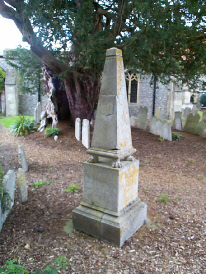 Mary Bourne is concerned,
the last of the name being the late generous lady occupant of Haven Hill. The family
tomb, an enclosed pyramid, stands near the yew tree on the South of the edifice,
and bears the inscription "Be ye also ready”, in reference to the husband of
the lady, who died in consequence of an accident.
Mary Bourne is concerned,
the last of the name being the late generous lady occupant of Haven Hill. The family
tomb, an enclosed pyramid, stands near the yew tree on the South of the edifice,
and bears the inscription "Be ye also ready”, in reference to the husband of
the lady, who died in consequence of an accident.
The name Dowling was associated with agriculture in the parish forty years ago, members of the family of that name then living at Link and St. Mary Bourne, and later at Middle Week, but they have now for some time ceased to be parochial residents. Tombs of several members of the family occupy sites on the south of the church and chancel.
The Herberts are also extinct in the parish, their tombs lie
on the north-
It is remarkable that there are not more records of the vicars.
We have notices of Stones and Easton in the chancel, and the latest vicar and some
members of his family occupy a small plot close to the chancel, surrounded with
a low wicket-
The Browns, Parhams, Taylors, and Vincents of Eggbury whose graves lie eastward of the chancel, have all left the district; and the tomb of the Hooper family of Stoke stands close by.
The Mundays lying southward of the church are of some parochial antiquity; and the Poores whose graves are close by, have being resident in "Bourne" before 1545.
Among those who have for centuries placed their dead in the graveyard Gibbons is an example, known as Gibbe in 1327,and now often styled Gibbs, Churcher or Kercher, appears at the same date. Mills, formally spelt Mylls; Becley, afterwards Beckley; Bright, Izorne, Purver, at one time Purvyer, a purveyor or victualler probably, Harris, once spelt Harrys, Sims in past times Cynes, and Phillpot, were connected with the parish in 1545. Carter, Fisher, and Sutton are also early residents. Their dead were the "rude forefathers" of the hamlet.
There was another family of Holdways, who were possessed of land at Stoke, whose dead lie on the southeast of the church. They are also parochially extinct.
The Neales, who lie not far distant from the Holdways are yet respected residents; as also are the Medhurst’s, whose graves are on the North of the church, near the North gate.
William Day, laying in the east part of "God's Acre", and many years a churchwarden, is of quite modern date in the village.
One labourer's record should be copied, which may be considered
suitable probably too many other hard working men who lie unrecorded, that of William
Bower, at whose last illness I was present thirty six years ago. On an old fashioned
wood label extending from end to end of the grave, and supported with head and feet
posts, it is written that-
For forty years (he was) the faithful and respected farm servant of Mr. Robert Longman, of this parish. He maintained himself by his own honest earnings during life. Died May 1851, aged 77 years.
Mary Goodyear the centenarian lies at the foot of the grave of the recently buried vicar. (Samuel J. I. Lockhart)
Other names of Wedge, Gale, Biggs, Crooks, Bull, and Broad are names of some parochial antiquity.
On the south of the church several plain alter tombs close to
the road are appropriated to the L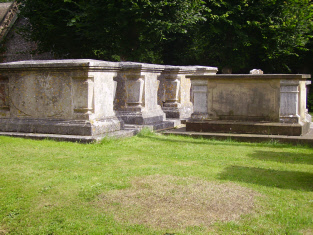 ongman family, who for a lengthened period occupied
the Week hamlets; and members of the same family lived at Apsley, and Wadwick, also
called Warwick, this family is also parochially extinct, some members emigrated
to Saskatchewan in Canada, in the latter part of the 19th.century. The last male representative was the benevolent owner
and occupier of Wadwick, whose family tomb stands beneath the wall at the east end
of the graveyard, in a plot of ground presented for burial purposes by himself and
his brother. The marble tomb is distinguished by a broken lily, in reference to
a daughter who died early. Close by it, as if implying that those who were remarkable
for lengthened residence desired to be near each other in death, is the tomb of
Mr. John Moore, the last of his family; the name if ancestrally the same, which
it most likely is, is found in the list of parochial residents in the time of Edward
3rd. The earlier Moores lie on the north side of the church; one of a line of grave
stones bearing an inscription to the memory of William Moore, who died in 1789.He
was the father of the late John Moore, and was a churchwarden with Robert Longman
in 1785.The inscription reads thus-
ongman family, who for a lengthened period occupied
the Week hamlets; and members of the same family lived at Apsley, and Wadwick, also
called Warwick, this family is also parochially extinct, some members emigrated
to Saskatchewan in Canada, in the latter part of the 19th.century. The last male representative was the benevolent owner
and occupier of Wadwick, whose family tomb stands beneath the wall at the east end
of the graveyard, in a plot of ground presented for burial purposes by himself and
his brother. The marble tomb is distinguished by a broken lily, in reference to
a daughter who died early. Close by it, as if implying that those who were remarkable
for lengthened residence desired to be near each other in death, is the tomb of
Mr. John Moore, the last of his family; the name if ancestrally the same, which
it most likely is, is found in the list of parochial residents in the time of Edward
3rd. The earlier Moores lie on the north side of the church; one of a line of grave
stones bearing an inscription to the memory of William Moore, who died in 1789.He
was the father of the late John Moore, and was a churchwarden with Robert Longman
in 1785.The inscription reads thus-
|
A loving uncle a friend sincere |
|
Loved by most people lies buried here |
|
Kind to the poor of the meaner sort |
|
We hope that Christ will reward him for't. |
|
|
|
|
"A loving father" is not an uncommon commencement on tombstones, but "A loving uncle" is somewhat novel.
(Dr. Joseph Stevens)
Near the east end of the church a low wire enclosure marks the
resting place of Mr. Samuel John Ingram Lockheart, (1802-
In his story are we coming upon the birth and growth of a legend? Those who knew him intimately remember him as an autocratic dignified man with a flavour of the eighteenth century well in which he was born about him; one who unbent to entertain children who loved him; one whose affection for his wife led him, it is said, after her death, to have his coffin made of the wood of an acacia he had planted in the garden when he came to the village, a tree his wife had loved, which had to be felled. His act may be sentimental rather than eccentric. It was sentiment too, that made him wish the coffin to be made big enough for the books he had used so many years in the church to be buried with him, a wish that was not fulfilled, for in the end there was no room in the coffin. One other wish caused much talk at his death. He defied an old accepted custom by leaving instructions in his will that he was to be buried on the third day after his death. The local custom insisted on a week's waiting, winter or summer and whatever the cottage accommodation. These idiosyncrasies have rational enough explanations. The few old inhabitants, who remember him, when asked what he was like, smile. "Oh! He was a queer gentleman" "Why "?" He had his coffin made long before he died, and he was queer in the house. He had a room he wouldn't let nobody go into".
But children, now old, who were his friends, were taken into it, and know why he looked after it himself. It was crammed with treasures, valuable curiosities he had brought from all parts of the world, china from far away and long ago, which had belonged to his mother and grandmother and you "mustn't touch".
It was in a sort of door-
The picture is of one different from most of those among whom he laboured a character not understood by them, and the centre of tales and surmises. (Kathleen Innes)
In the late 1970's.the churchyard was "tidied up" and controversially many of the headstones were lost, some of the existing headstones are markers and do not necessarily mark the original grave positions they have since been listed under the monuments act. One of the headstones has been restored and is on display in a monumental mason’s museum in Great Bedwyn about 10 miles away. It is mounted on the wall next to the post office and belonged to Robert Holdway and his wife Sarah and there grandson John, and dates from 1729. (Kevin Holdway)
A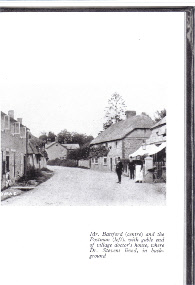 nother
colourful character was the carpenter William Batsford (1841-
nother
colourful character was the carpenter William Batsford (1841-
They lived in an old,
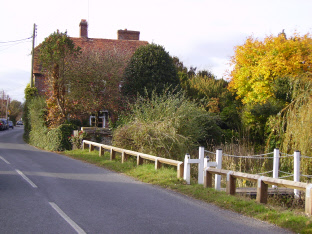 mellowed brick house with
a fine tiled roof in the middle of the village. Their two surviving daughters married
and went elsewhere, and they stayed as Darby and Joan to a ripe old age. They had
not only a store of country lore, but were observers themselves of country superstitions.
On the walls of their sitting room were nailed round, mouldy objects, added to each
year, hot cross buns, supposed if ground up and drunk in water to be preventive
of cholera. The cure was fortunately never put to the test. She practiced old and
dying handicrafts, such as lace making on net, and tried in vain to pass them on
to a more restless generation. The infant’s wing of the school remains as a memorial
of his craftsmanship. In their old age no ordinary dog or cat was their pet, but
a large and truculent goose which accompanied his master for walks, and hissed at
strangers in an alarmingly protective fashion!
mellowed brick house with
a fine tiled roof in the middle of the village. Their two surviving daughters married
and went elsewhere, and they stayed as Darby and Joan to a ripe old age. They had
not only a store of country lore, but were observers themselves of country superstitions.
On the walls of their sitting room were nailed round, mouldy objects, added to each
year, hot cross buns, supposed if ground up and drunk in water to be preventive
of cholera. The cure was fortunately never put to the test. She practiced old and
dying handicrafts, such as lace making on net, and tried in vain to pass them on
to a more restless generation. The infant’s wing of the school remains as a memorial
of his craftsmanship. In their old age no ordinary dog or cat was their pet, but
a large and truculent goose which accompanied his master for walks, and hissed at
strangers in an alarmingly protective fashion!
Proud of his work, the old man was very remiss over sending his accounts as if he scorned payment. One day Dr. Stevens, anxious to pay for a job he had had done, and unable to get a bill, asked for it with some impatience. "That's all right Doctor, “he was answered, I’ll take it out in medicine someday".
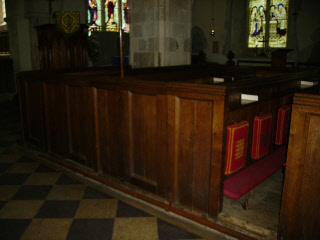 The carpenter's determined procrastination over jobs he did not care about once
gained him a permanent victory over the doctor. The front pews in the church have
doors originally marking off the seats occupied by the "gentry" from local
"Houses" from the door-
The carpenter's determined procrastination over jobs he did not care about once
gained him a permanent victory over the doctor. The front pews in the church have
doors originally marking off the seats occupied by the "gentry" from local
"Houses" from the door-
When the carpenter's wife died, the one piece of work in which he found consolation was the carving of a fine oak memorial for her grave. He worked on it, slowly and feebly, but lovingly, for months, and when it was finished and placed in position he had no further interest in life, and soon followed her to the grave. (Kathleen Innes)